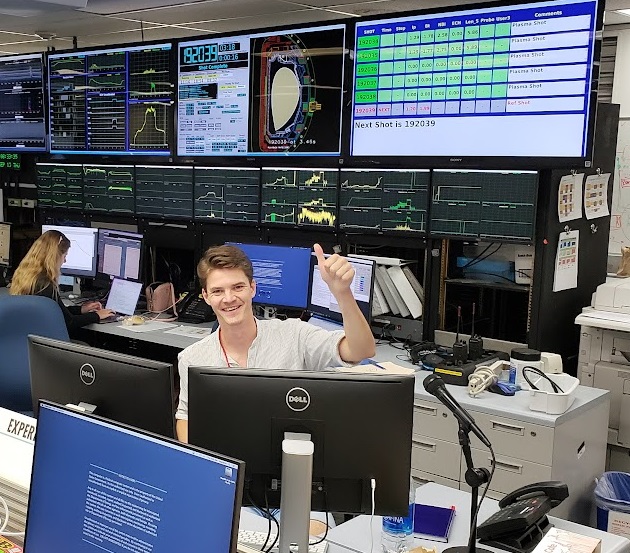This summer, I visited General Atomics to perform experiments on the DIII-D tokamak in the beautiful San Diego. The experiments are part of my graduation project at DIFFER and the Eindhoven University of Technology, and the visit was supported financially by FuseNet.
In high-power tokamaks like ITER, additional fuel and impurity gas are injected to mitigate the immense heat and particle loads on the divertor targets. The gas injection must be controlled to ensure the survival of the divertor targets and optimize fusion performance. However, to ensure the stability and robustness of the gas injection controller, we require knowledge and models of the divertor plasma dynamics, which is presently research in progress. Nevertheless, we can measure the divertor plasma’s dynamic response to gas injection in present-day tokamaks. These measurements help understand the physical processes that govern the divertor plasma dynamics and provide a benchmark for dynamic models. Performing these measurements on DIII-D is the goal of my graduation project.
In the experiments, we perturbed the gas injection with carefully designed multi-sines and observed the dynamic response of the divertor plasma with diagnostics. The measured response contains the same frequency content as the multi-sine perturbations and is used to characterize the divertor plasma dynamics, so-called frequency response measurements. These dynamic measurements have been performed by perturbing the injection rate of deuterium and nitrogen in forward and reverse toroidal magnetic fields. Therefore, the experiments provide a rich database of fueling and impurity seeding dynamics and are a first step in studying the effect of cross-field drifts on the divertor plasma dynamics.
During the experiments, I was assigned the role of session leader in the control room, which meant I had to prepare the experiments and make decisions between shots to ensure we obtained the desired results. Working in this environment taught me a lot about how experiments are done and significantly deepened my understanding of tokamaks. Furthermore, I experienced what it is like to do research in the field of nuclear fusion, which I hope to continue in the future!
Finally, I recommend everyone do an internship at General Atomics. It is a beautiful work environment with fantastic people. The city of San Diego is lovely to explore, ranging from beaches, parks, and excellent Mexican food to the typical Californian weather. At last, I want to express my gratitude to FuseNet for supporting this fantastic opportunity and thank my supervisors at DIFFER and General Atomics for providing the thrust and opportunity of this amazing project.

